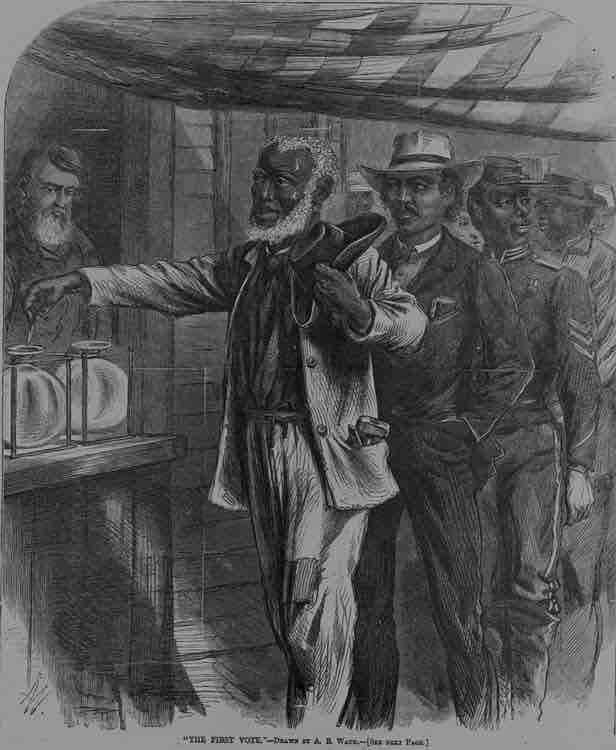African Americans
For a large part of US history Black voters were blocked from voting, either directly or through political practices that targeted Black voters indirectly.
Today, the average participation of African American voters is still somewhat lower than white voters, but there is great variety within these voting patterns.
There are different explanations for voting patterns. Institutional approaches look at the ways in which legal documents and organizations impact the ability to vote. Others examine the question of rationality in voting: does voting serve the self-interest of any given individual, and what are the interests or issues that might change someones voting patterns? A behavioral approach focuses on the actions of individuals and groups, taking voting as one part of a larger bundle of political activities. In examining African American voting patterns it is helpful to consider all of these factors.
Civil War and Institutional Barriers
During the period before the Civil War, enslaved Black people, and many free Blacks and free people of color were barred from voting. At the end of the war, the fifteenth amendment, ratified in 1870, banned any state from denying the right to vote to any adult male citizen based on his race.
During the early Reconstruction period, Black residents voted in large numbers . In many states the enslaved population had been larger than the free population. Coupled with a strong set of shared interests, there was a great deal of incentive for Black citizens to vote.

The First Vote
This contemporary print depicts the first Black voters in the US exercising their new rights.
Jim Crow Era and Disenfranchisement
While the fifteenth amendment provided legal protection for voting rights based on race, during the Jim Crow era, politicians created new institutions to suppress the vote of Black residents.
Early on, violence and intimidation was used to keep Black voters away from the polls. States then began to pass official voter suppression legislation. These included poll taxes requiring payment before voting, and literacy and understanding tests, strict residency requirements and new voter registration rules.
While these rules did not specifically restrict Black citizens from voting, Black people who were freed slaves and their descendants were disproportionately poor, less educated or illiterate, and so more likely to have their voting rights limited by these provisions. Although it is important to note that poor white residents were also disenfranchised by many of these provisions. In some cases, states added character or grandfather clauses to permit poor or illiterate white residents to continue voting.
Civil Rights
During the early parts of the 1900s, the NAACP brought forward several successful cases to challenge state voter suppression laws. In the 1950s and 1960s, the civil rights movement became a widespread social movement. Groups fought for improved opportunities for African American people, and tried to defend existing rights that were being denied. Civil rights leaders organized communities through churches and other community groups, and attracted the support of many white activists from northern states.
The African-American Civil Rights Movement encompasses social movements in the United States whose goal was to end racial segregation and discrimination against black Americans and enforce constitutional voting rights to them. This article covers the phase of the movement between 1955 and 1968, particularly in the South.
The movement was characterized by major campaigns of civil resistance. Between 1955 and 1968, acts of nonviolent protest and civil disobedience produced crisis situations between activists and government authorities. Federal, state, and local governments, businesses, and communities often had to respond immediately to these situations that highlighted the inequities faced by African Americans.
In 1962, the twenty-fourth amendment to the Constitution prohibited congress or states from restricting voting through poll taxes. In 1964, the Civil Rights Act was passed. In 1965, the Voting Rights Act established federal oversight of election regulations, and banned voter qualifications or prerequisites that limited the right to vote on account of race or color. This act removed a large institutional barrier to voting and helped to further protect voting rights.
2008 and Beyond
The 2008 presidential election was historic, with Barack Obama as the Democratic candidate, and the first non-white presidential candidate for a major party. Obama had a Kenyan-born Black father, a white mother from the Midwest, and strong connections in the African American community in Chicago. Aside from the fact that Obama won an overwhelming percent of the African American vote, there was also high levels of African American voter turnout during this election. This was in part because of self-interest and a desire for representation, but was also the result of strong community organizing. Once again, grassroots groups and social movement leaders worked to register voters and get them to the polls.